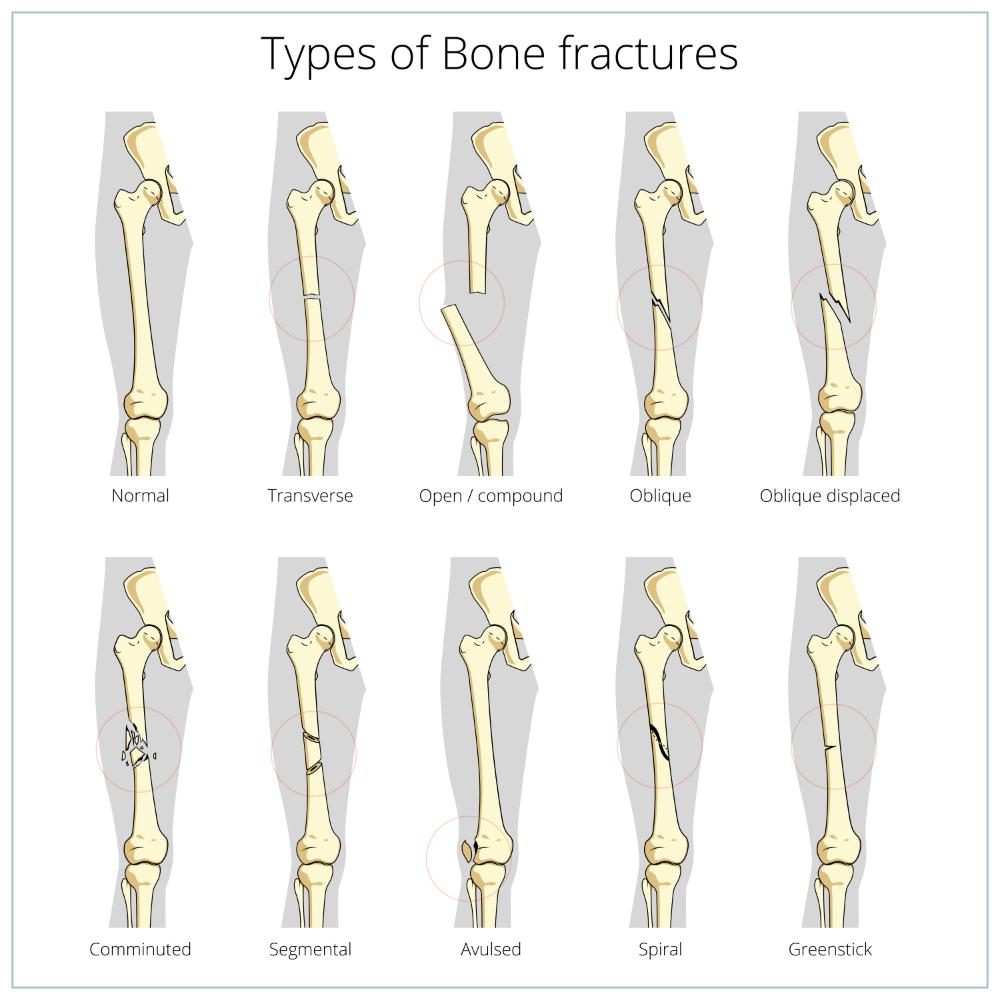Fractures in children occurs when a bone partially or completely breaks due to external pressure applied by a direct hit, a sports injury, or an accidental fall. Injured bones can vary in severity from open to closed fractures:
- Open or compound fractures happen when the broken bone damages the outer layer of the skin and pokes through it.
- Closed or simple fractures occur when the bone breaks but does not damage the skin.
Older children might be able to explain their symptoms and how they got injured, making it easier to identify a fracture. However, knowing whether your baby or toddler has a broken bone can be more challenging since they may struggle to communicate their discomfort.
It is important to remain vigilant to the potential signs of a fracture and seek prompt medical attention. The key symptoms of a fracture include:
- A snap or grinding sound when the injury occurs
- Inflammation, redness, and bruising around the injury
- Intense pain that tends to increase
- Pain that worsens when moving the injured area
- Visible deformity
- A broken bone poking through the skin
- Dizziness and shivering
If your child has fractured a bone, call our medical care at Robertson Pediatrics immediately and try the following tips:
- Give them over-the-counter painkillers like paracetamol or ibuprofen according to the dosage instructions on the packaging.
- Avoid moving the injured area.
- Use scissors to remove the clothing around the injury very carefully.
- If possible, put a splint or sling on the injury to hold the bone still until your child can see their doctor.
- If you suspect the injury is severe, avoid giving your child food or beverages in case they need urgent surgery.
Call 911 immediately if you suspect that your child has severely injured their head, neck, or back or if a broken bone sticks out of the skin.
A fracture happens when a bone is subjected to more pressure than it can absorb. In children, it is common that these injuries are caused by the following factors:
- Trauma: A fall, an accident while riding a bike, or a tackle during a soccer game could cause the fracture of a bone.
- Osteoporosis: This medical condition causes bones to weaken, making them more susceptible to breakage and injuries.
- Overuse: Repetitive motions when playing sports can tire out muscles and place more pressure on the bone, causing fractures.
A bone can fracture in multiple ways. Some common types of fractures include the following:
- Comminuted fractures occur when a bone breaks into several fragments. These commonly happen because of a car accident or another serious injury.
- Greenstick fractures happen when a bone bends instead of breaking. These are often seen in children whose bones have yet to develop fully.
- Oblique fractures occur when a bone is bent in a curve or at an angle, leading to breakage.
- Open, compound fractures happen when the skin is pierced by a broken bone or by a blow that breaks the skin at the time of the fractures.
- Pathologic fractures occur when bones become weak and fracture with ease due to certain conditions like osteoporosis.
- Stable fractures happen when the broken ends of the bones line up and are barely out of place.
- Stress fractures are characterized by hairline fractures in the bones.
- Transverse fractures generally occur when a direct blow causes bones to break at a 90-degree angle to the long axis of the bones.
Once you and your child have arrived at our clinic at Robertson Pediatrics, your medical provider will analyze your child’s medical history, conduct a physical exam, and request imaging tests to help identify the type of fracture.
These tests may include the following:
- X-rays use electromagnetic energy to have a basic overview of the child’s bone injury.
- Magnetic Resonance Imaging (MRI) uses a magnetic field and radio waves to develop detailed images of the child’s nerves, soft tissues, and bones.
- Computed Tomography (CT) Scan uses multiple X-ray images to create a cross-sectional body view. This might be especially useful if your doctor suspects your child might have osteoporosis.
Treatment for a fractured bone focuses on realigning the broken pieces back together. This is achieved using a cast, splint, or brace to immobilize the broken bones and promote healing. These supportive measures don’t heal broken bones on their own but aid in ensuring healing happens in the proper alignment.
Cast immobilization is the most common type of fracture treatment. After the bones have been correctly realigned, plaster or fiberglass casts are used to keep the broken ends in the proper position as they heal.
On the other hand, a brace allows the controlled movement of nearby joints. These are especially helpful for minor fractures.
The traction method for fractures involves applying a gentle, steady pulling action to realign the bones. This is commonly used when cast immobilization is not recommended due to the location or type of fracture.
When broken bones do not heal as expected with casts alone, your doctor may suggest surgery to pin the broken bones back together. It is usually performed for fractures that involve joints or when the broken bone sticks out through the skin.
Common surgical procedures for fractured bones include external fixation, open reduction, and internal fixation.
- External Fixation: This procedure involves placing metal pins or screws to the broken bones that will be connected to a metal bar outside the skin. This device helps to stabilize and hold the bones in the proper position while they heal.
- Open Reduction and Internal Fixation (ORIF): During this procedure, bone fragments are first properly repositioned and then held together with special screws attached to the bone's outer surface.
After returning home from the clinic, encourage your child to fully rest and avoid physical activities for at least a few days. This helps prevent damaging the cast, which could cause the fractured bone to misalign and heal in the wrong position.
While caring for your child’s fracture at home, it is essential to:
- Monitor their pain and symptoms.
- Keep the injured area in an elevated position with the help of extra pillows.
- Follow all care instructions with precision.
- Ensure their cast remains dry at all times to avoid irritation.
- Help your child remove their sling before bedtime.
As a fracture injury starts to heal, the body forms blood clots around the broken bone to protect it and deliver the necessary cells to restore the damaged area.
With time, healed tissue, also known as a callus, will start to form around the injury, joining the broken bones together. This tissue will eventually become stronger over the following weeks while new bone structure develops.
Although this process occurs within a matter of weeks to months, complete healing can take a lot longer.
When the cast is removed, it is normal for your child to experience muscle strength loss around the injured area due to the immobilization.
Once the cast is removed, your doctor will recommend specific exercises to help restore muscle strength, joint motion, and flexibility. For dry and itchy skin, it is recommended to bathe with warm, soapy water and apply non-perfumed moisturizer.
While accidents like falls or sports injuries can happen unexpectedly, you can follow preventative measures to reduce the risk of fractures in your child.
- Create a diet rich in calcium and vitamin D to promote bone strength.
- Encourage weight-bearing exercises, such as running, to help keep their bones healthy.
- Ensure your child wears proper safety equipment when riding a bike or while practicing contact sports.
- Install safety gates at bedroom doors and at the end of stairs.
- Avoid using infant walkers since they significantly increase the risk of injuries in babies and toddlers.



